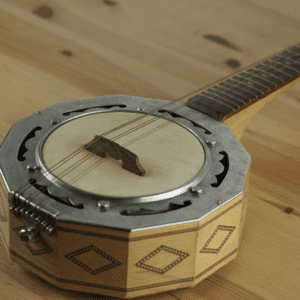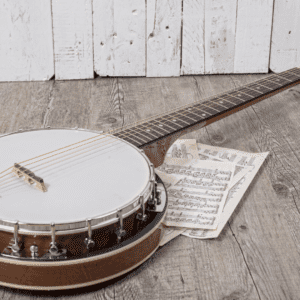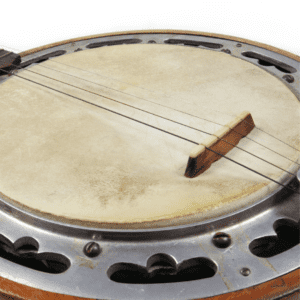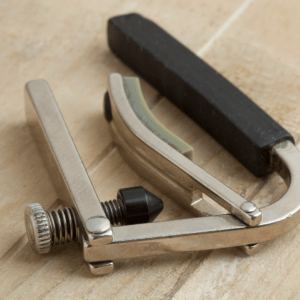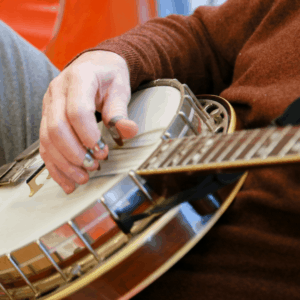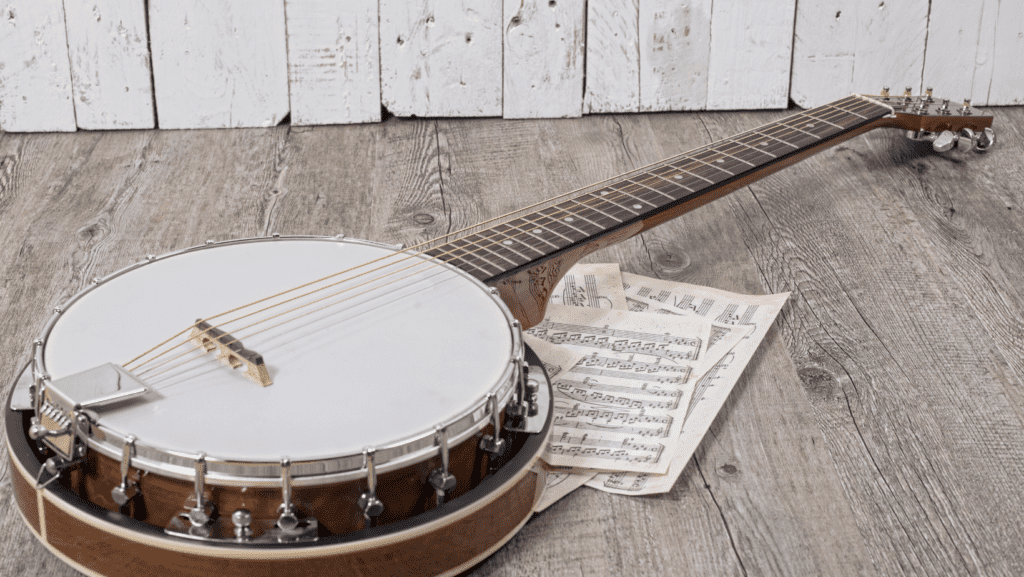
If you’ve decided to start learning the banjo, you may have come to realize that there are two popular ways of playing; clawhammer and bluegrass. Clawhammer banjo is typically played on a 5 string open-back banjo. Bluegrass banjo is usually played on a weightier and louder banjo with a resonator.
Clawhammer and bluegrass also refer to different styles of playing. We can differentiate these by the different playing techniques employed. To play clawhammer, the back of the nails and thumb are used to make a peculiar scoping motion. It’s called clawhammer because you are hammering down on the strings with your hand shaped like a claw. You can play clawhammer style on any banjo but certain features make it easier, such as a lower string action, and an open back. These all come together to lend a more mellow sound.
Let’s look at some of the best clawhammer banjos on the market.
| 1. Best Overall Clawhammer Banjo – Deering Goodtime 5-String Openback Banjo A slim, all maple body USA-built banjo made by a highly reputable manufacturer. | Buy on Amazon | |
| | 2. Best Budget Clawhammer Banjo – Mulucky 5 String Banjo Choose from a maple or mahogany body. Has everything you need to start learning. 3-way adjustable truss rod and 24 chrome-plated brackets. | Buy on Amazon |
| | 3. Best Beginner Clawhammer Banjo – Pyle, 24 Bracket, Geared 5th String Banjo A great quality-to-price ratio banjo with a removable sapele resonator, and an adjustable truss-rod. Also includes a beginner’s pack. | Buy on Amazon |
| | 4. Best Maple-Body Clawhammer Banjo – Aklot 5 String Full Size Maple Banjo Open Back An affordable maple-bodied banjo with a clear tone. Low string action, two-way adjustable truss rod, and a Remo drum head. | Buy on Amazon |
| | 5. Best Electric Clawhammer Banjo – Ortega Guitars Raven Series 5-String Open Back Where modern and traditional meet. A clawhammer banjo with a piezo pickup with an eye-catching ebony look. | Buy on Amazon |
| 6. Best Portable Clawhammer Banjo – Gold Tone Plucky Banjo A travel-friendly banjo with a neck resembling an average banjo. Includes a gig bag. | Buy on Amazon |
6 Best Clawhammer Reviewed
Best Overall Clawhammer Banjo – Deering Goodtime 5-String Openback Banjo
Deering is one of the most well-regarded makers in the banjo world. Their instruments are USA-built. If you want a quality-built instrument for the clawhammer style, then you couldn’t go wrong with the Deering Goodtime 5 string open-back banjo.
The neck is made from a gorgeous slender maple that many musicians find comfortable to play on for extended periods. The fretboard is high-quality ebony and the trim is attractive and draws your attention with its contrast of black and white.
The truss rod is adjustable so you have the option of configuring it whatever way matches the tone you want. The banjo weighs only 4 pounds, which makes it perfect for children or adults to learn on, or to take it with you when you travel.
Pros
- USA built by renowned manufacturers for peace of mind and quality assurance.
- Maple body.
- Fiddle-shaped peghead.
- Long-lasting satin finish.
- Slim neck.
- Comes with a deluxe padded gig bag and chromatic tuner.
Cons
- Maybe slightly pricey for a beginner.
Best Budget Clawhammer Banjo – Mulucky 5 String Banjo
If you’re looking for a banjo to start learning clawhammer style, then the Mulucky 5 string could be an option for you. You can choose from a maple or mahogany body, with the former being marginally more expensive.
The head is designed by the renowned drum company Remo. The head is secured by 24 chrome-plated brackets and a 5/8″ maple/ebony bridge. The brackets are fully adjustable and there’s a three-way adjustable truss rod so you can get just the sound you want.
Also included is a starter pack with everything you need to begin; spare strings, tuner, 2 tuning wrenches, 4 picks, a strap, 1 ruler, a cleaning cloth, and a gig bag.
Pros
- The beginners’ pack comes with everything you could need to start learning the banjo.
- Choice of maple or mahogany body.
- 3-way adjustable truss rod.
- 24 adjustable chrome-plated brackets.
Cons
- Requires some setup out of the box.
Best Beginner Clawhammer Banjo – Pyle, 24 Bracket, Geared 5th String Banjo
If you’re still trying to find your feet in the world of banjos, then the Pyle banjo starter pack might be what you need. If you’re still not sure if you’d prefer to commit to an open back or resonator banjo, then why not get both? This Pyle model features a removable polished sapele wood resonator. This gives you the option of trying different playing styles, such as clawhammer and bluegrass before committing to a more expensive instrument.
The versatility of this model by Pyle doesn’t mean it’s lacking in quality; it’s a 38.6” instrument with 24 brackets, 22 frets. The body is sapele hardwood, with chrome-plated hardware. There’s a geared 5’th string tuner and high-quality Remo drumhead. There’s also a truss rod to stop the wood morphing when the climatic conditions change.
Pros
- Removable polished sapele resonator so you can try different styles.
- Reasonable price.
- Good quality relative to the price.
- Includes a truss rod.
- A starter pack gives you what you need to begin learning the banjo.
Cons
- The versatility of the instrument (the removable resonator especially) may mean you’ll outgrow the capacity of this banjo fairly soon.
Best Maple-Body Clawhammer Banjo – Aklot 5 String Full Size Maple Banjo Open Back
The all-maple construction of the Aklot 5 string banjo gives it a bright and clear tone that is surprising considering the price. The banjo is open back, with a professional Remo drum head to provide a professional sound. The head is fixed by 18 brackets for greater stability. They’re also adjustable so you can get the sound that’s right for you.
You’ll also fund a two-way adjustable truss rod on the neck and drum head. The bridge is solid wood. There’s also a bull saddle, which can optimize string vibration and give you a superior tone. Included is also a starter pack that includes everything someone new to the instrument could need to start strumming (or picking.)
Pros
- Affordable price.
- All-maple construction lends a clear and bright tone.
- Professional Remo drum head.
- Two-way adjustable truss rod.
- Low string action- perfect for clawhammer style.
Cons
- Requires some setup out of the box.
- The items in the starter pack aren’t the best quality.
Best Electric Clawhammer Banjo – Ortega Guitars Raven Series 5-String Open Back Acoustic-Electric Banjo
If you’ve got one foot in tradition and the other looking forward to the future, then consider the Ortega Guitars Raven Series Open-Back Banjo. If you’re looking for a banjo to play old-time music on, but also want the unlimited options of playing an electric banjo, then this could be a good option for you.
The mahogany neck and rosewood fretboard are stunning, and the black satin finish is eye-catching. There are 24 brackets and a Remo ebony head, chrome hardware, and die-cast tuning machines. It includes a passive piezo pickup to amplify your sound. You can also play it acoustically, and the pickup doesn’t negatively affect the sound in any way.
Also included is a handy deluxe gig bag
Pros
- Clawhammer-style banjo with a pickup.
- Beautiful appearance.
- Built with quality woods.
- Includes a travel bag.
Cons
- Not the best option if you want a traditional banjo.
Best Portable Clawhammer Banjo – Gold Tone Plucky Banjo
The Gold Tone plucky banjo is perfect for your backpacking adventures, weighing in at a mere 2 pounds. Don’t let the small size fool you, it’s not a toy. You can tune this miniature-sized banjo to open C or D. The neck width is similar to a normal-sized banjo, so you won’t have to adjust your playing too much or compromise on tone.
It’s also set up in the Gold Tone factory in Florida with its larger brothers and sisters. The string action is low to ease playability. Take it with you anywhere; on the trail, or give it to a child to learn clawhammer style banjo on. If you’re interested in small portable banjos, consider looking into the banjolele as another option to think about.
You can also change the string gauge if you want to play with others in standard open G tuning. Also, check our banjo capo guide if you’re planning on jamming with other musicians and will need to play in different keys.
Pros
- Small size and big tone.
- Made by a well-respected manufacturer in the banjo world.
- Has a similar-sized neck width to average-sized banjos.
- Take and play it anywhere or give it to a child to learn on.
- Includes a sturdy carry bag.
Cons
- Some people complain about the setup and the tuners.
Keytar Buying Guide
History Of The Keytar
We can trace the roots of the banjo back to the influx of West African Slaves. There are accounts as early as 1620 of banjo-like instruments being played in West Africa. They featured a drum which was an animal skin stretched over the hard shell of a gourd. The neck was a stick of wood with strings attached to produce various tunings.
The transatlantic slave trade gathered more and more momentum in the 1600 and 1700s, and more of America was colonized. These West African slaves brought their instruments with them to the plantations where they were forced to work. These early banjo prototypes were commonly played clawhammer style, which was then often referred to as stroke-style, frailing, or framming.
By the 1800s, the banjo had assumed its now common 5 string form with tuning pegs. But, it was still fretless at this point. They were still most popular with slave musicians and were used as a rhythmic accompaniment to the melody of a fiddler. These early dance tunes are what are now referred to as old-time standards.
In the 1830s, white musicians such as Joel W. Sweeney learned stroke-style banjo from the African slaves and popularised the style in the minstrel shows of the era.
What Are The Differences Between Clawhammer And Bluegrass Style?
3-finger style or bluegrass banjo is fast-paced and conjures up images of barn dances and the like. Clawhammer, as a style, is more associated with a laid-back evening plucking the banjo on the porch in front of your house.
Simply put, clawhammer is a rhythmic, strumming style and bluegrass/3 finger is a picking style. Clawhammer style relies on the downward strumming of the strings with the index or middle fingers followed by the thumb. 3 finger style relies on the thumb, index, and middle fingers to pluck the strings. 3-finger/bluegrass rarely utilizes any strumming whatsoever.
Bluegrass vs Old Time Music
Clawhammer has its roots in the instruments and playing styles that the West African slaves brought with them on their forced transatlantic journeys. This style of playing is often used for what in the USA is called old-time music. Old-time music is heavily influenced by African music, including music by the ancestors of what has become the banjo as we know it today.
Bluegrass is a much more recent development in the history of the banjo. Earl Scruggs is single-handedly credited with the invention of the bluegrass banjo playing style when he performed at the Grand Ole Opry in December 1945. His unique playing style was influenced by his sibling Junie Scruggs and a few old-time clawhammer players. He introduced a fast series of notes called ‘rolls,’ each of which usually contained between 4-8 notes.
Bluegrass banjo, often referred to as Scruggs style, is thrilling due to its speed and the sheer amount of notes a musician plays. It’s often associated with virtuosity and lightning-fast musical dexterity.
What’s The Difference Between A Clawhammer And A Bluegrass Banjo?
Clawhammer banjos are usually open back and have a smoother and gentler tone. Bluegrass banjos have a resonator that gives them a much louder and punchier sound. A resonator is a hardwood cover at the back of the banjo.
If you’re looking to buy a banjo to play clawhammer on, an open-back design is preferable. It will ensure that the fast notes you play don’t all intermingle with each other in the resonance chamber and create a muddy sound.
A 5 string setup is essential for clawhammer style, as without the 5th string you won’t be able to play the characteristic rhythm of the style.
Resonator banjos are commonly used for bluegrass. The main difference between a clawhammer and resonator banjo (or bluegrass banjo) is the sound chamber at the back. This is usually a wooden or metal bowl at the back of the banjo where the sound reverberates. Resonator banjos tend to be more expensive due to the extra materials and construction required to make them.
You also find more upmarket clawhammer banjos now that have failing scoops. This is when the higher frets have been ‘scooped out,’ for players who prefer to strum higher up the neck for the more muted tone this offers.
Can You Play Clawhammer Style On A Resonator Banjo?
Yes, you can play clawhammer banjo on a resonator banjo. The reverse is also true; you can play bluegrass on an open-back, clawhammer banjo.
The differences between clawhammer and resonator banjos are also due to the fact that bluegrass bands often contain more instruments that the banjo has to compete with in terms of volume. A resonator aids projection immensely.
In the old style of playing the banjo, of which clawhammer is descended, players would strum by themselves or without bigger outfits common with the much newer bluegrass music. As such, clawhammer banjos didn’t need to project their sound as much as they weren’t competing with other instruments for sounds-space.
This allowed them to have open backs, where a lot of the vibration is absorbed into the player’s body. It also makes the sound mellower and less punchy. This in turn allows for softened melodies and players often play rhythmically by the typical clawhammer strumming pattern.
What Features To Look For In A Clawhammer Banjo?
Most clawhammer players prefer an open-back banjo. Look out for a low string action to help facilitate quick and smooth chord changes characteristic of clawhammer style.
To Sum Up
The clawhammer style is the oldest style of banjo. It’s the type of banjo that most closely resembles the West African instruments that originally inspired the proto-banjos of the 17th century. Whilst not as popular as its much younger sibling, the bluegrass music played on resonator banjos, clawhammer still has a lot to offer budding musicians.
Clawhammer style is much gentler and often more nostalgic than bluegrass music. Luckily if you’re more interested in learning this style, clawhammer banjos tend to be more economical than their bluegrass counterparts. This is because of the extra material and labor needed for the resonators typical of the style. Clawhammer banjos are much lighter as well and consequently easier to play for extended periods than the much weightier resonator banjos.
Yet, just because you buy a clawhammer banjo, doesn’t mean you’re confined exclusively to the style. You can still learn bluegrass on a clawhammer banjo and vice versa.
Our Top pick clawhammer banjo, the Deering Goodtime 5-String Openback Banjo comes with an all-maple construction and is made in the USA. The slim ebony fretboard is comfortable to play and the instrument is a joy to look at.
Last update on 2023-04-27 / Affiliate links / Images from Amazon Product Advertising API


